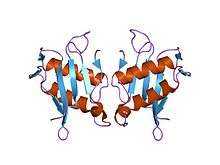Killer toxin Kp4 family
In molecular biology, the killer toxin Kp4 family is a family of killer toxins, which includes the Kp4 killer toxin from the smut fungus Ustilago maydis.[1]
| Kp4 | |||||||||
|---|---|---|---|---|---|---|---|---|---|
 structure and function of a virally encoded fungal toxin from ustilago maydis: a fungal and mammalian calcium channel inhibitor | |||||||||
| Identifiers | |||||||||
| Symbol | Kp4 | ||||||||
| Pfam | PF09044 | ||||||||
| InterPro | IPR015131 | ||||||||
| |||||||||
Killer toxins are polypeptides secreted by some fungal species ("killer yeasts") that kill sensitive cells of the same or related species, often functioning by creating pores in target cell membranes. The fungal killer toxin KP4 from the corn smut fungus, Ustilago maydis (Smut fungus), is encoded by a resident symbiotic double-stranded RNA virus, Ustilago maydis P4 virus (UmV4), within fungal cells. Unlike most killer toxins, KP4 is a single polypeptide.[1] KP4 inhibits voltage-gated calcium channels in mammalian cells, which in turn inhibits cell growth and division by blocking calcium import. KP4 adopts a structure consisting of a two-layer alpha/beta sandwich with a left-handed crossover.[2]
References
- Park CM, Bruenn JA, Ganesa C, Flurkey WF, Bozarth RF, Koltin Y (January 1994). "Structure and heterologous expression of the Ustilago maydis viral toxin KP4". Mol. Microbiol. 11 (1): 155–64. doi:10.1111/j.1365-2958.1994.tb00297.x. PMID 8145639.
- Gu F, Khimani A, Rane SG, Flurkey WH, Bozarth RF, Smith TJ (August 1995). "Structure and function of a virally encoded fungal toxin from Ustilago maydis: a fungal and mammalian Ca2+ channel inhibitor". Structure. 3 (8): 805–14. doi:10.1016/s0969-2126(01)00215-5. PMID 7582897.